In the era of globalization, learning new languages has become essential. People need to study foreign speech to do business, make friends, and just travel. However, teaching kids secondary languages is getting popular, too, especially ESL or so-called English as a Second Language. There are several reasons.
Contents:
First, children have more advantages in language learning than adults. They are immersed in the environment and learn the speech by absorbing it through contact. Kids do not have formal instructions for using the language, so they aren’t afraid to make mistakes. Also, people avoid judging children for any slip-ups — this helps boost confidence and motivation. In terms of educational content, it’s delivered in a playful manner, where success brings various achievements, snacks, and toys. As a result, kids learn languages faster and more efficiently.
Second, this market is rather lucrative. The ESL sector takes around 80% with approximately $44 billion in revenue, while ESL for kids is about 32% of the language e-learning market.
So, creating a language learning app for kids is an excellent idea for a startup or an expansion of an existing service. In this article, we will dwell on the business model, must-have features, technical stack, approximate development costs, and a list of popular competitors.
When studying a language, children absorb around 12.5 million bits of information. It’s about two bits per minute. This amount of data fit into a regular floppy disk.
— The Week Magazine
What business model should a language learning app have?
Before starting the development, it’s crucial to create a detailed business plan. For starters, research the target audience, possible rivals, demanded features, popular educational methods, and so on. Once you have this information, you can start selecting the options for the future mobile application.
Target audience. It can be babies, toddlers, or teens. Generally, psychologists recommend teaching languages to kids from the age of three and up to the age of eleven. This time is the period when the brain actively grows. So discover possible attractions and pains of these users. For instance, babies’ apps to learn languages will be straightforward, with short videos and flash cards. A teen’s version can be more advanced and include speaking practice, various tests, and longer videos on particular situations.
Also, the target audience can be divided by skill level. Do you want to make an application for amateurs or those who already have language learning experience? This fact will influence the educational method you choose and task complexity.
Monetization. To pay off the mobile app development, you must pick a way to earn enough income. Language learning apps and websites usually offer:
- Freemium: people can utilize the app for free or purchase a subscription to access the pro features;
- Paid subscription: there can be a free trial, but one must buy a specific plan to continue working with the application;
- In-app purchase: you can sell various bonuses to improve the user experience. For example, character skins, ‘gems’ for keeping up the streak, bonus lessons, etc.
- Ads: earn money by showing personalized advertisements. Be careful, though — too many ads can push people away.
- Course fees: if you offer online courses, workshops, or other periodic educational content, you can charge a fee for access. This can be a straightforward way to generate revenue.
- Affiliate marketing: partner with businesses that provide products or services related to your content and earn a commission for each sale made through your app.
- Sponsorship: you can also seek sponsorship from businesses or organizations that align with your target audience. This can include brand placement, sponsorships, or partnerships with relevant companies.
Best languages learning apps like Duolingo combine freemium with in-app purchases. This option helps user retention since people can still study without paying money.
Languages. There are more than 7 000 spoken languages in the world. Which ones to include in the mobile application apart from English? It’s better to opt for the most widespread ones; ten or twelve languages will be enough for starters. So, be sure to offer Mandarin Chinese, Hindi, Spanish, Arabic, French, and others. Some applications boast 40 languages and more. However, it’s pretty expensive to support correct localization for all materials. Also, it’s hard to keep everything updated with that vast selection.
Experts and methodology. You need to hire experts to develop the lesson plan for each presented language. It’s better if they are native speakers with a teacher’s degree, at least for the popular languages. Also, the experts should suggest a suitable methodology, like concentrating on speaking or vocabulary extension. In this case, you can guarantee that the mobile app will be helpful and become successful on the market.
Apart from these options, the business plan for apps to learn a language should also include the available budget, possible expenses, etc. If the product is a startup project, it’s wise to choose the MVP or Minimal Viable Product strategy. In this case, the application will have only must-have features necessary for entering the market. The non-essential options will be added with later updates. This way, a small developer team can concentrate on crucial tasks, saving lots of time and money. As a result, they release a high-quality product that competes with medium-sized companies or even enterprises.
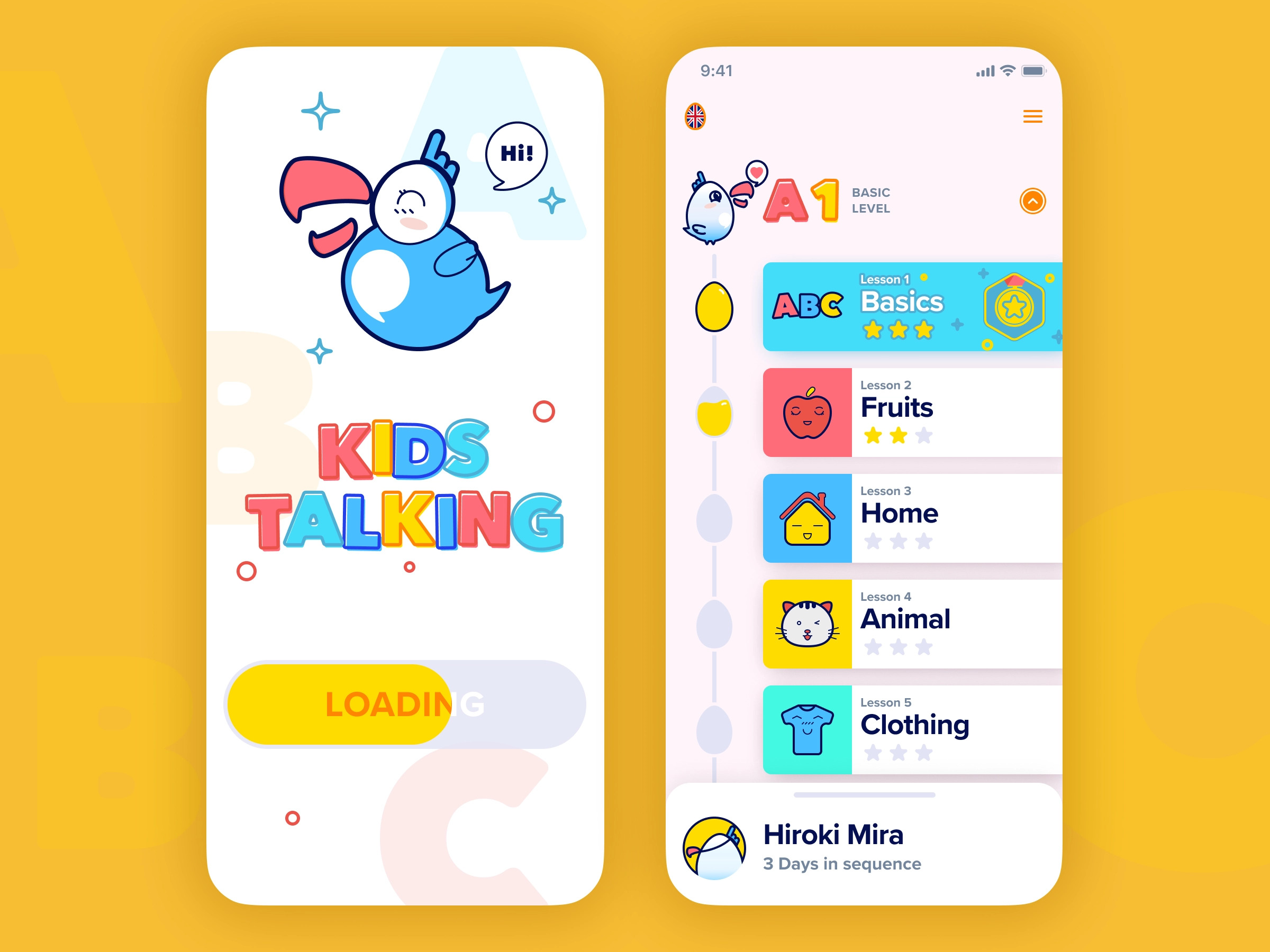
Concept by Anton Khmilovskyy
What features should language learning apps for kids have?
The application should offer specific features that are essential for becoming popular and helpful for kids.
Necessary options:
- Gamification: kids learn through play. So they need materials delivered as a game, preferably with various activities. Also, try adding different achievements to motivate the young users to study harder;
- Simple workflow: kids don’t have a rich user experience with mobile apps, so it’s better to implement an easy-to-grasp UI/UX without complex routes;
- Cute graphics: children like cartoons and cartoon characters, so add such illustrations to lessons. The great idea is to create a friendly-looking mascot to accompany kids through their language journey. This way, you establish a closer connection between the children and the application. It will also help branding since your app will be associated with this character. For example, Duolingo uses a cute little owl as a mascot.
- Personalization: for an e-learning application, this means providing unique content based on the user’s mistakes. Does a kid have difficulties with understanding grammar? Then they get more tasks aimed at polishing these skills. Is their favorite topic connected with cats? Let’s use cats’ stuff or characters during the language studies.
- Fonts with high readability: small kids may have problems with reading texts. As a solution, use easy-to-distinct fonts of a reasonable size. Alternatively, you can also add a voiceover for some parts to increase comprehension;
- User profile: people should be able to set up a profile for their kid and adjust necessary notifications and reminders.
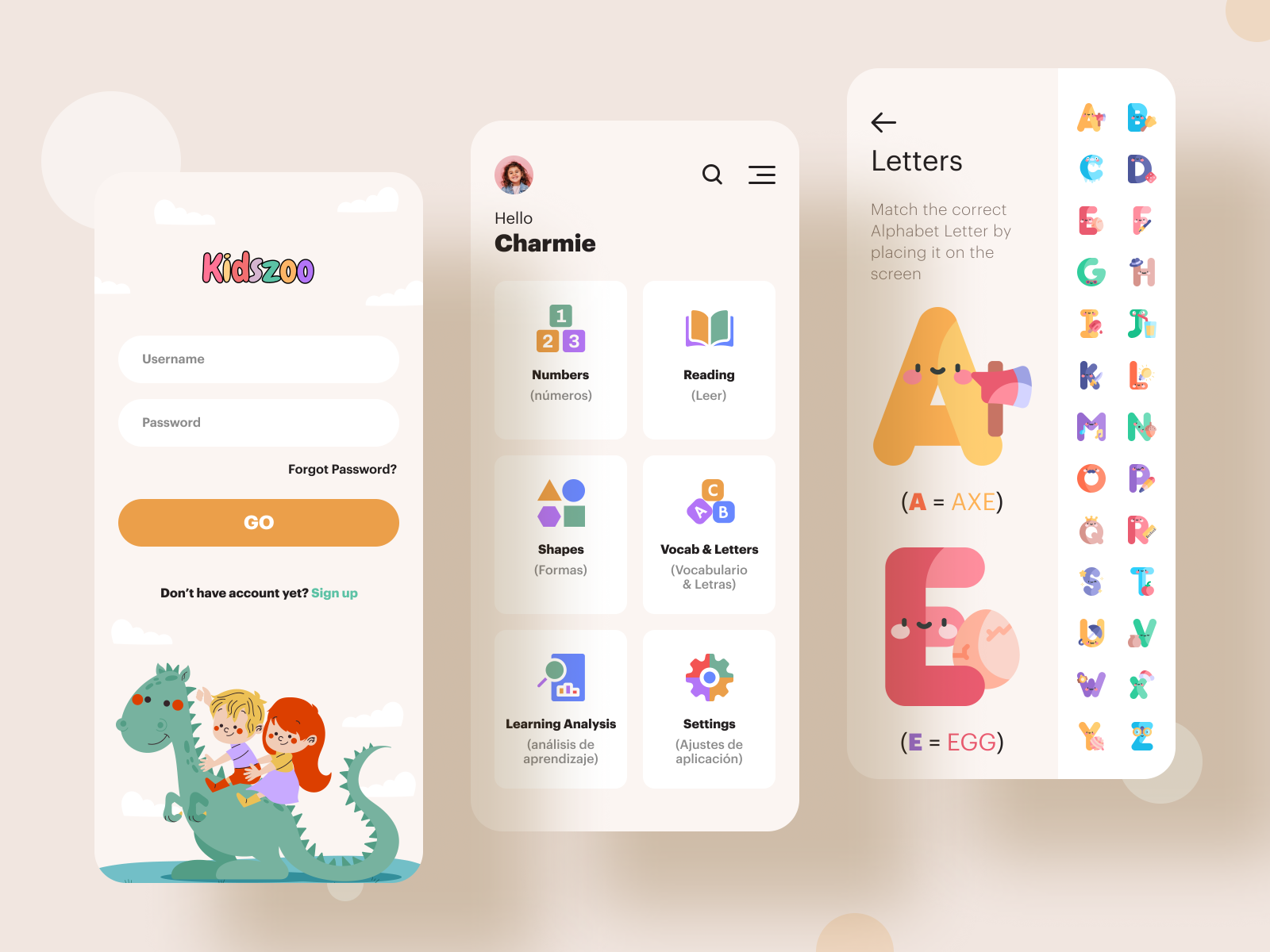
Kidszoo by MindInventory UI/UX
There are other non-essential options you can add to grant the app for language learning more utility in the eyes of parents and children. The product can be released without these. However, they increase the overall value.
- Task reminder: parents are humans, and they can forget about the language lesson in the neverending daily routine. This feature will help them remember and stimulate their child to study daily. It can be realized as pop-ups or push messages appearing at a specific time above other applications;
- Progress monitoring: it looks like a calendar where the mobile application marks attended and missed lessons. Parents can also check this option to see if the child keeps studying without strict overseeing. It’s a great idea to praise kids with small in-app gifts or achievements for long streaks;
- Voice recognition: to provide speaking practice, you will need to implement a technology to recognize the kid’s voice. It requires a voice recognition API, for instance, Google Speech, Bing Speech, iSpeech, or others. Remember that children don’t always speak distinctly, they can distort some words, so API should be versatile enough to understand the sentences;
- Pronunciation check: this feature goes together with speech recognition since you need to see if the user has made any mistakes. The technology compares the recording with the voice lines spoken by the natives and pinpoints any deviations;
- Emotional feedback: for better motivation, place praising messages during and after lessons, as well as in statistics. This way, a kid will feel their progression;
- Offline access: if a device doesn’t have an Internet connection, the user should still be able to study. Allow people to download the lessons to their smartphones and continue practicing languages;
- Socials: teens can connect their social media accounts with an application. This way, they can boast about their achievements and find language partners.
Once you select the essential and non-essential features, time to find what tools your team needs for their implementation. Let’s take a look at different parts of app development.
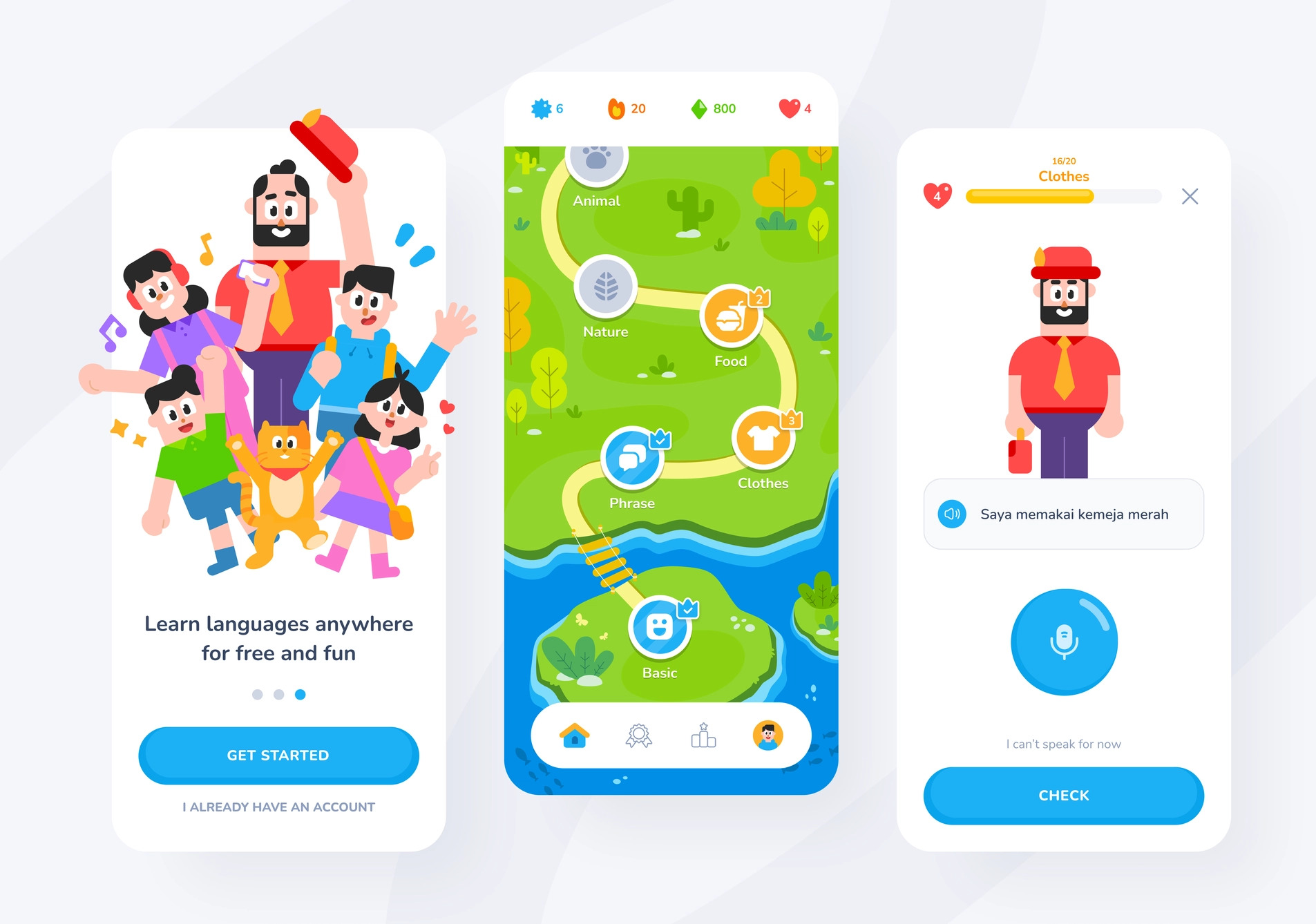
Ketto app by Wahyu Pratama
What technologies do you need to develop a language learning app?
The first step is to pick the release platform: iOS, Android, or both. Each system has suitable tech stacks you can use in your mobile application. In the case of a startup project, it’s wise to opt for one platform. Otherwise, your team will stretch out too much, and the quality of the end product will be poor.
Frontend
It’s connected with everything on the client’s side and UI/UX. The team needs to build layouts and components and create attractive visuals and animations. The mobile development stack can contain Java, JS, or Objective-C programming languages. For web elements, one can use CSS3 and Bootstrap.
Backend
This type of development is related to the server side, which regular users don’t see. Here you can use Node.js, the JavaScript runtime environment. It’s a perfect choice for startups and MVP products since this tech provides scalability and faster build testing, deployment, and delivery. If the release platform is Android, implement Java or Kotlin programming languages. Swift is a reliable option for iOS systems.
Database
When selecting a database for apps to learn languages, it’s crucial to prioritize personal data protection and robustness to heavy load. MySQL or Cassandra is a popular choice in that field. Alternatively, consider using a relational database like PostgreSQL. It doesn’t offer fast processing but grants high-security standards. In terms of non-relational databases, check out MongoDB since it has both speed and flexibility.
Cloud storage
It provides data backup, collection, and analytics. There are several technologies, like Google Cloud and Amazon Web Services. They are friendly to startups and often provide loyalty programs with free trials.
Push notifications
To deliver various info messages and task reminders, you can go for native solutions: Google Cloud Messaging or Apple Push Notification. However, it’s also possible to implement a third-party service like Twilio, Nexto, or others.
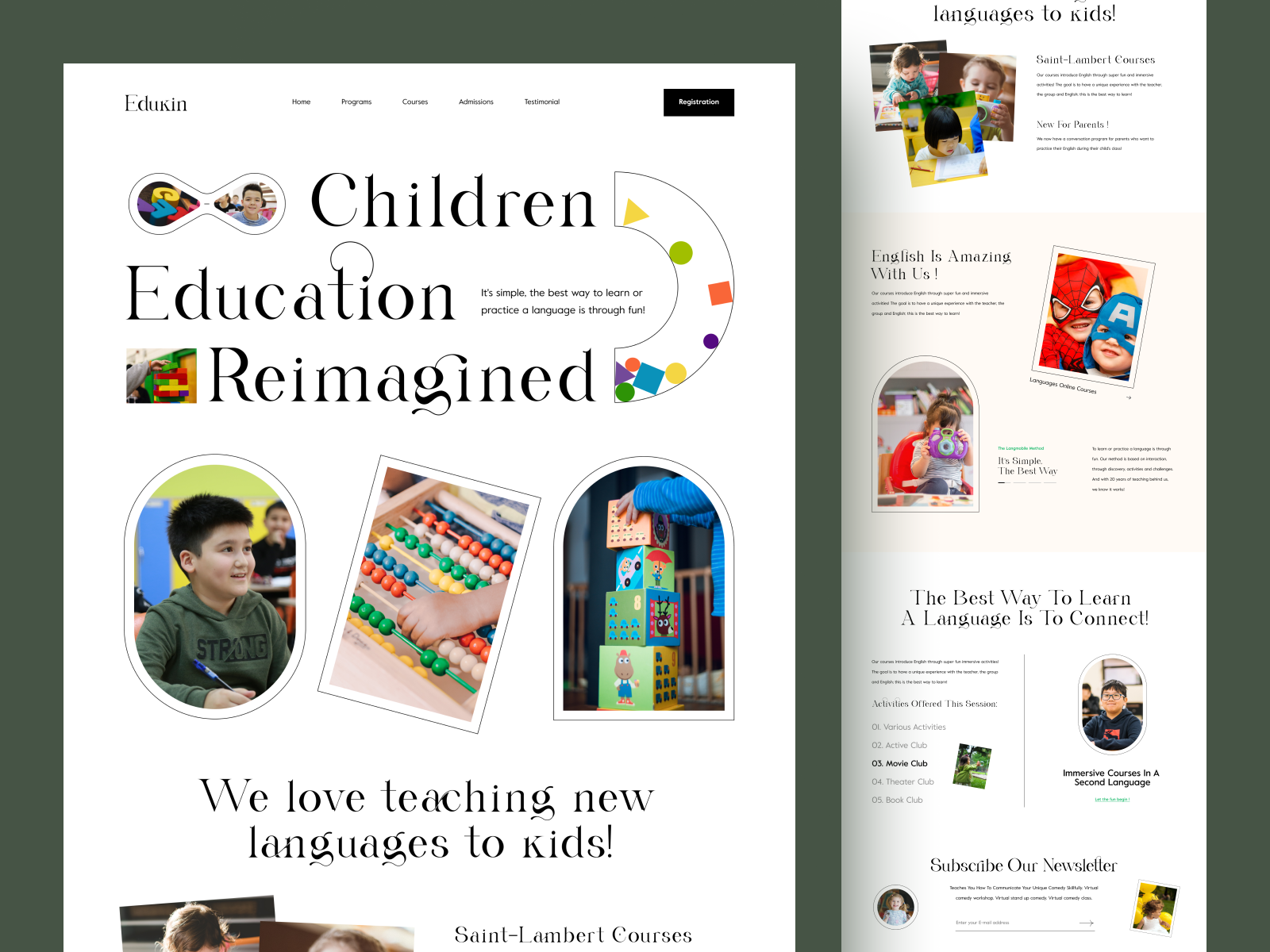
Child education website by Sajon
How to create an educational app
To develop a successful project, it is important to outline a plan of action first, including finding a unique idea, conducting proper market research, testing with target audiences, and building an MVP with basic features. For instance, while no-code app constructors may offer a cheaper and easier solution for creating an e-learning application, it is important to be aware of the drawbacks, such as the inability to create custom solutions, maintainability issues, and possible problems with getting the product to stores.
Design
The design also requires careful consideration of its intended users and their goals. For example, the UI/UX of a learning app meant for children may feature colorful themes, animations, and illustrations, while an application intended for adults may have a more sober and minimalist design. However, every educational software should prioritize the UX by capturing users’ attention, engaging them with learning activities, offering meaningful experiences, and enabling social interaction.
The type also influences the design. The management platforms are better suited for strict minimalistic looks that resemble public education, with no distracting details. In contrast, games benefit from cute animations, illustrations, and cartoon styles that entertain people while they study.
Applications concentrated on a specific subject, such as a programming language, tend to have similar minimalistic designs with small colorful elements and little branding. To ensure a smooth, continuous flow, a sense of achievement, ease of use, and a clear structure, developers use various tricks and trends.
Development
Developing an educational app for iOS or Android requires a team of specialists, including:
- Project manager
- UI/UX designer
- Mobile developers
- Back-end developers
- QA engineer.
You can either hire an in-house team or outsource the work to a company. While in-house teams offer better communication, they can be more expensive. Outsourcing to developers from different parts of the world can provide the same level of expertise at a more affordable cost.
As for the target devices, native development, specifically for iOS or Android platforms, tends to be more costly but offers a more customized and quality-oriented approach. Cross-platform development is less expensive but comes with limitations, such as animations and 3D objects. Consulting with professionals before making a decision is essential.
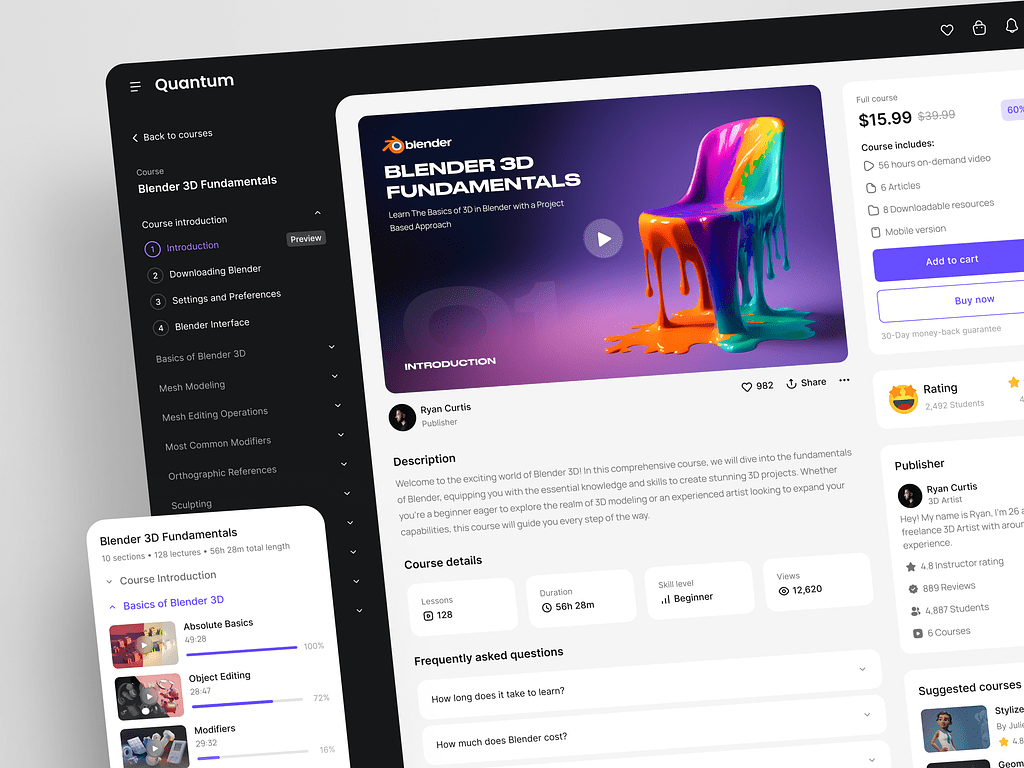
Online Education Web Platform by Conceptzilla
How much does a language learning app for kids cost?
The development cost depends on a lot of factors: team experience, time spent, release platform, technology stacks, amount of features, design level, etc. You should also include expenses on additional services, like promotions, QA testing, server hosting, placement into stores, and reviews.
To lower the costs, you can hire an outsource development team instead of the in-house one. In this case, the price per hour may be lower: $40-45 for development and $70-80 for design. However, such a team needs more time for onboarding, as well as regular online meetings for the progress check. Moreover, it’s also vital to count time expenses as well. The shorter the cycle, the faster the product will get into the market.
Simple concept
A simple app for language learning with 5-10 frames and no animation or VFX will be the cheapest option. Especially if you don’t need full-cycle branding or pro-level features like voice recognition. In this case, the approximate prices will be:
- About 240+ hours;
- Approximately $10 800 for the development;
- About $19 200 for the design.
In total, the average costs will be around $30 000 if you work with an outsourced team.
Advanced concept
If we take a more advanced approach with 2D animated illustrations, well-thought-out UI/UX design, and premium features like registration, chats, profiles, etc., it will be rather expensive. However, such an app will attract more attention in the market. The possible expenses are the following:
- About 700+ hours;
- Approximately $28 000 for the development;
- About $56 000 for the design.
The average total cost can hit $84 000 and even higher. Such products are suitable for medium-sized companies or enterprises that can cope with such expenses. Opting for simpler projects is better if you are just starting your business.
Custom concept
If you go for custom development with third-party integrations, the prices will be different. A simple app will cost around 450+ hours or about in total. A professionally-looking mobile application might take up to 1200+ hours or even more. Custom development allows you to create a truly unique product. However, one needs a reliable strategy and enough resources to pull it off.
6 Best language learning apps for kids: a short list
Researching potential rivals is essential. It lets you learn more about the current market demands and target audience. What’s more, you can find excellent solutions for your concept and attract more users with a better implementation of these features.
Here are the 5 most popular applications for studying foreign languages:
1. Duolingo
It offers courses in 30+ languages, including Klingon or High Valyrian from famous TV shows. It’s perfect for toddlers and teens since it provides personalized lessons and gamification with leaderboards. Recently the developers have added various stories that people can listen to and answer questions, improving their listening skills. Primary educational tools are familiar — it’s flashcards, filling in the blanks, translations, etc.
For babies, Duolingo offers Duolingo ABC. It’s an iOS application that concentrates on reading and writing.
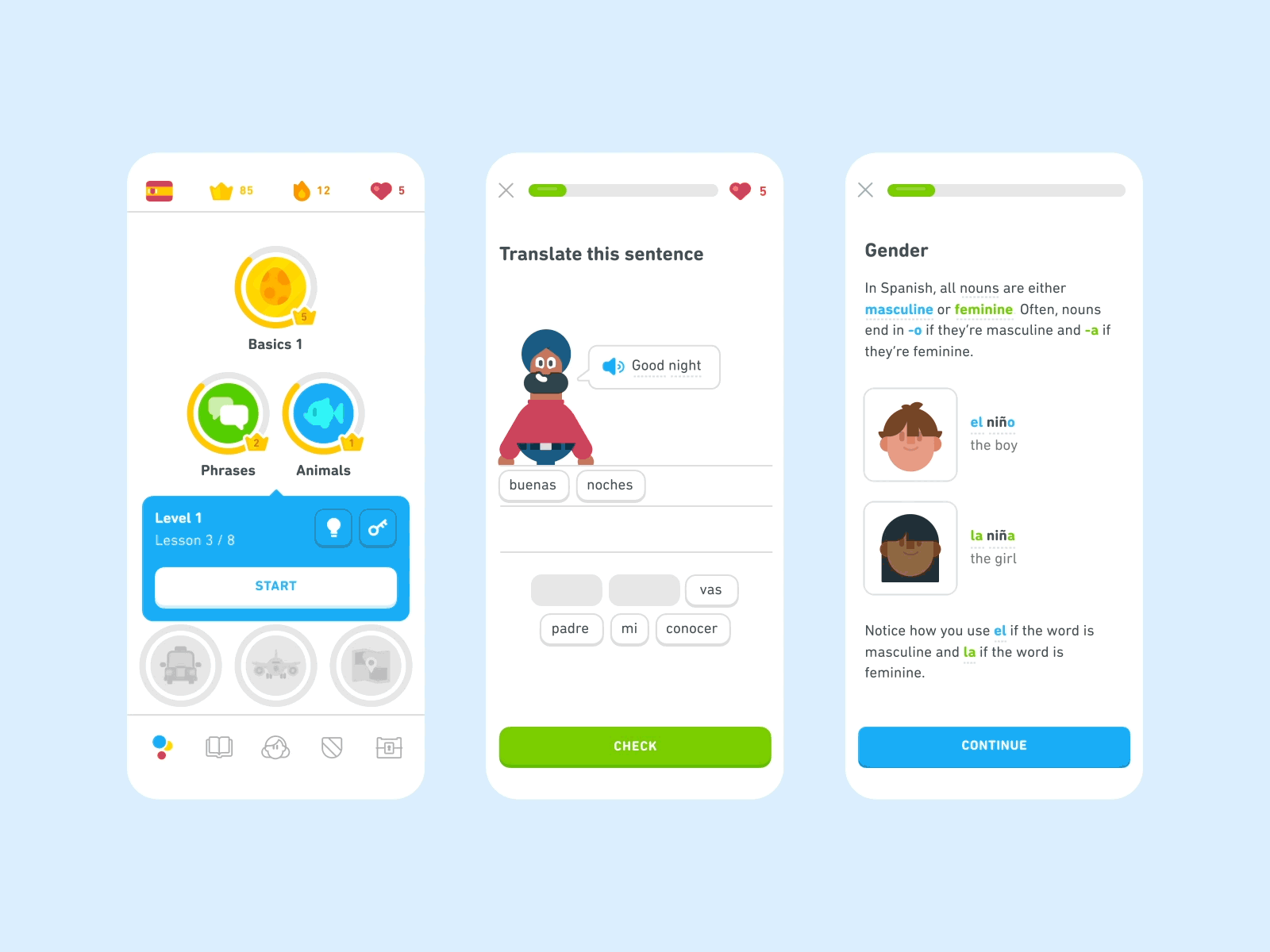
Duolingo UI shows progress and grammar explanations
It also allows kids to connect with friends and other language learners to boost effectiveness and motivation. Duolingo is a free language learning app, but there are premium features that allow the learner to skip ads, make more mistakes and practice them.
2. Little Pim
It is an online platform for babies, toddlers, and pre-k. Little Pim offers 12 languages, including English, ESL, Spanish, Chinese, and others. It also provides guides for parents and teachers to achieve the best result. The platform uses short videos and printable materials to expand children’s vocabulary. It’s subscription-based; there are monthly and yearly plans.

Little Pim offers many short videos
Little Pim relies on language immersion: five-minute videos help create a certain atmosphere. Parents can play them anywhere and at any time to keep the children involved.
3. Rosetta Stone
It’s one of the best apps for language learning. It’s suitable for toddlers and teens. Rosetta Stone has a vast toolkit: children can watch videos, listen to short stories, study phrases, and download lessons to repeat them at any time. There are 24 languages to study. Moreover, Rosetta Stone offers a special program for homeschoolers that allows children to fit language studies into their curriculum.
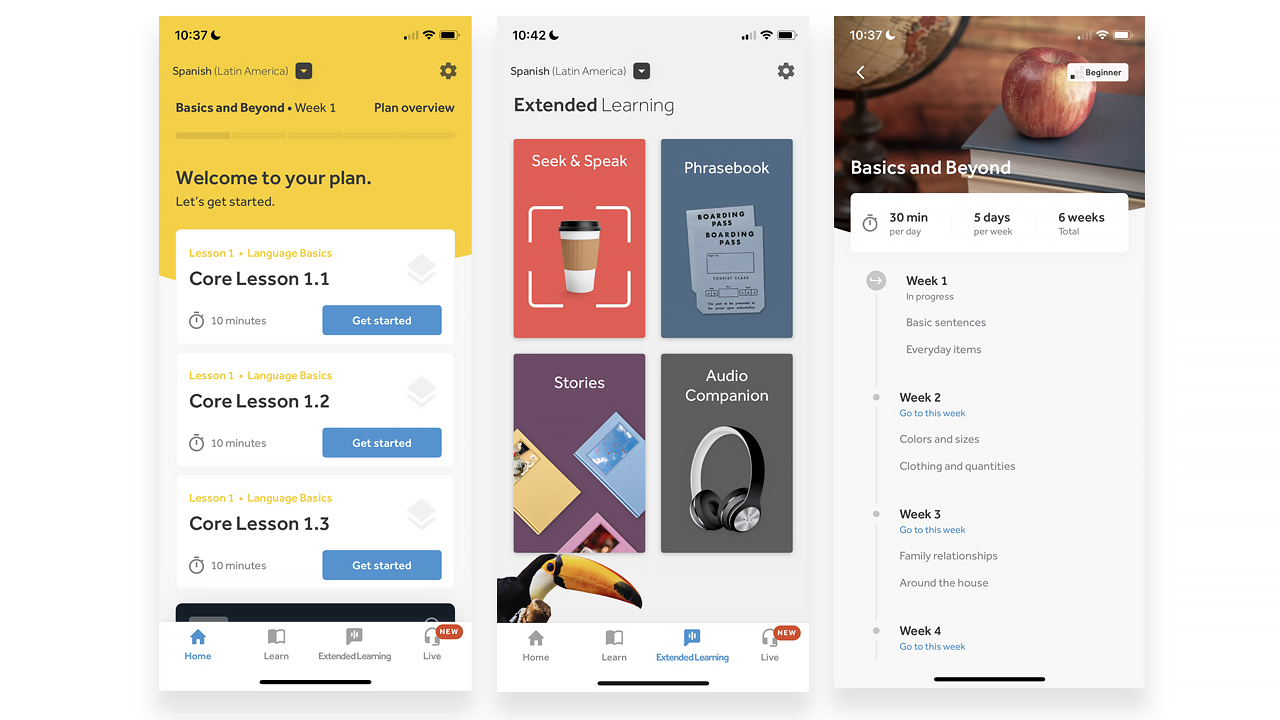
Rosetta Stone has detailed lesson plans
The product requires a subscription, whereas the pro plan provides a lifetime license and coaching by a native speaker. The mobile app works both online and offline, which is very convenient during travel.
4. Babbel
Babbel is a language learning platform aimed at teens 14+ and adults. It offers 13 languages and two ways of studying them. The first method suggests self-dependent studies using the application, the second one allows to attend online classes with native speakers. Both plans require a subscription.
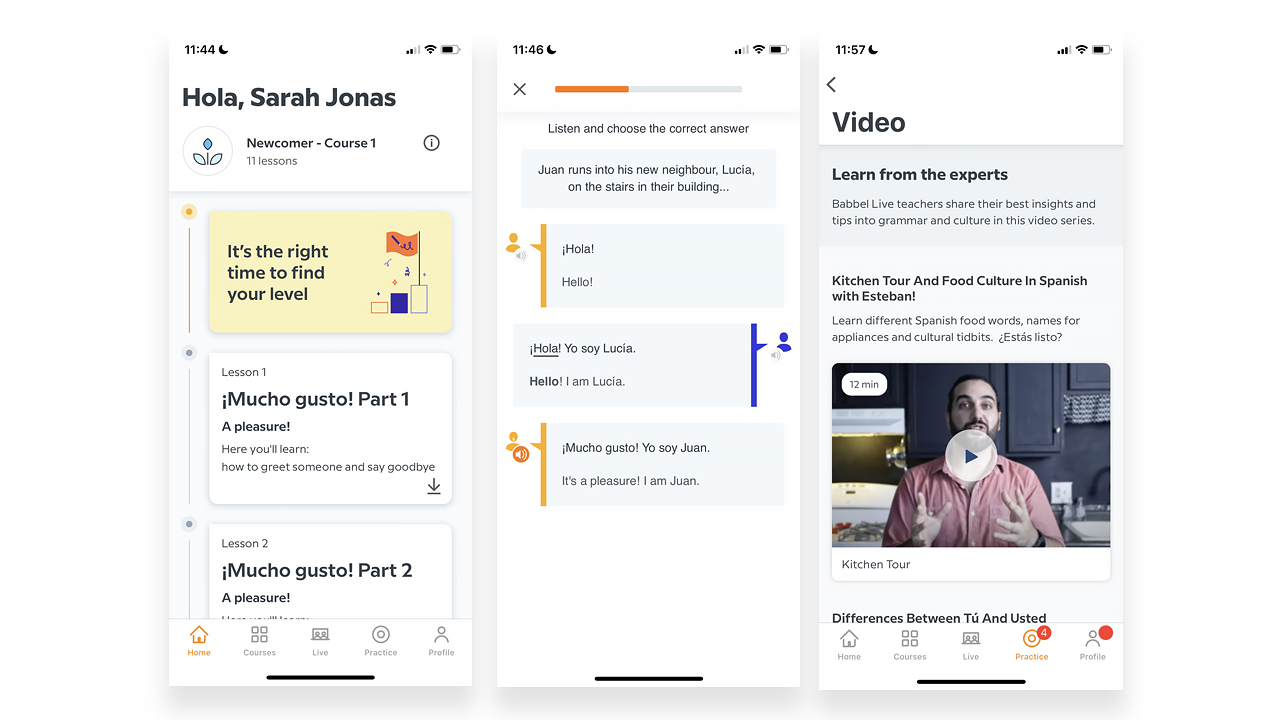
Chats and videos for speaking and listening practices in Babbel
Apart from videos and lessons, one can read Babbel’s magazine and listen to their podcasts. They serve as additional materials for expanding the language vocabulary and learning common phrases. The lessons are sorted by topics, and each includes various activities and speaking practices.
5. CatnClever
A great example of close work between startups and educational experts is CatnClever —an e-learning app for preschoolers and kids that we worked together on with the founders. It offers educational games in both English and German that were created in close collaboration with leading experts in audiovisual design and gamified learning. Apart from math and literacy skills, the app teaches kids about emotional intelligence, movement, social interactions, and music.

Cat’n’Clever app
There is also a convenient dashboard for parents or caretakers, where they can check their child’s learning progress. This way, parents can guide and support their kids’ learning journey.
6. Mondly Kids
It’s a variation of the regular Mondly language learning app for babies and toddlers. The product offers 40+ languages, including British and American English. It’s free to use. However, some features and perks require a subscription.
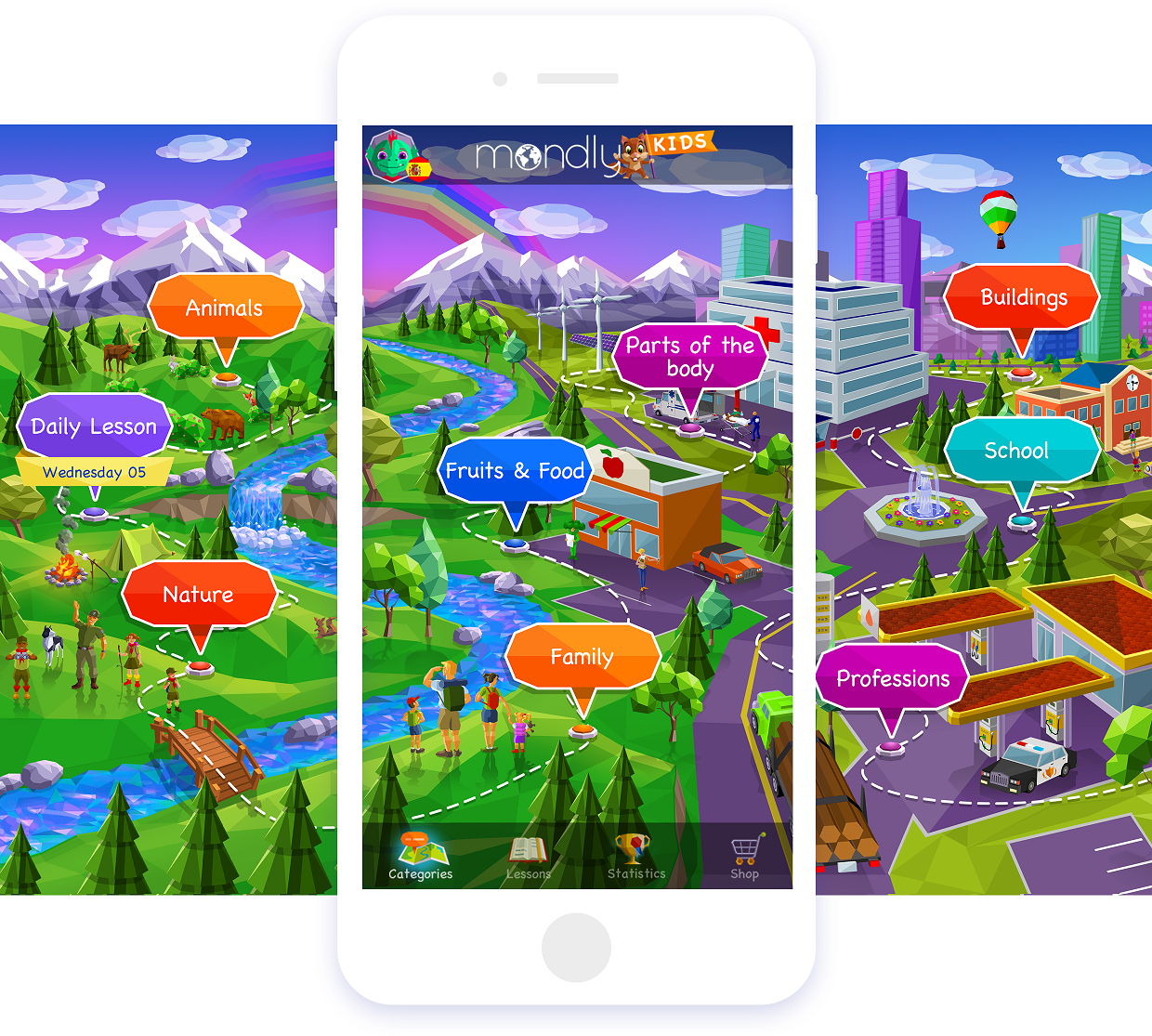
Mondly app really looks like a mobile game
The mobile application is built as a game to keep the children involved. The actions are simple: a kid just needs to swipe or tap the correct variants while listening to their pronunciation. The lessons are grouped by themes, where various animal characters accompany a child. For better motivation, there is progress monitoring and task reminders.
Educational apps market
The major key players in the e-learning market include Khan Academy, Rosetta Stone, Genshuixue, BYJU’S, Age of Learning, BenchPrep, PowerSchool, Blackboard, Socrative Student, Duolingo, and others. Overall, the outlook for this sphere in 2023 appears to be positive, with significant growth expected.
What’s more, significant growth is expected during the period of 2023-2028. The market is estimated to reach USD 102,602 million by 2031, expanding at a CAGR of 26.78%. The market size for education apps was valued at USD 24,706 million in 2021 and is expected to witness a substantial rise in revenue in 2023.
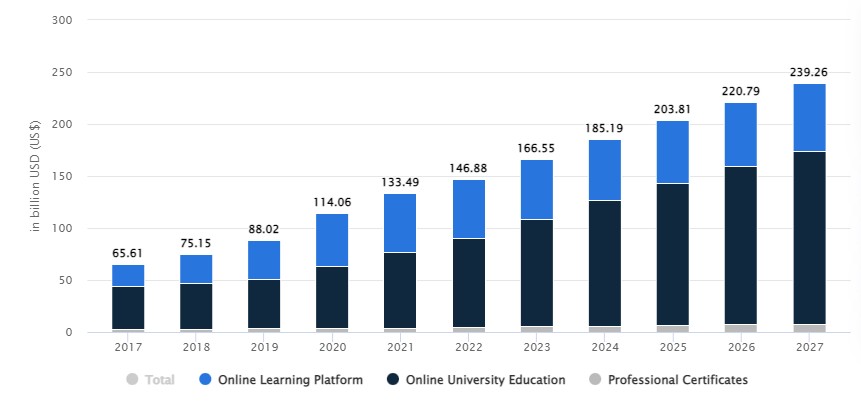
The demand for online courses has been increasing due to the need for virtual teaching and self-learning processes. The market is also growing due to the expanding focus on wearable technology in the educational space. Additionally, the developing adoption of smartphones and the penetration of the internet are also driving the spreading of the market. It is now a platform for testing the newest tech solutions, and it generates a huge income.
Top trends in e-learning app development
Education technologies are constantly evolving, and staying up-to-date with the latest trends is crucial for startups and small businesses. Here are some of the newest tendencies you should consider:
- Gamification: it means using game design elements in non-game contexts to make learning more engaging and enjoyable. This mechanic can be applied in apps for grown-ups too.
- Artificial Intelligence (AI): neural networks have a wide range of implementations: from personalized learning paths to automated assessments and grading. Increased use of smart algorithms is expected to bring massive changes to the world of e-learning, both in corporate and academic settings.
- Mobile learning: with the increasing use of smartphones and tablets, mobile learning has become mainstream. It allows people to access the materials from anywhere, anytime, and on any device.
- Microlearning: it refers to the delivery of short, bite-sized pieces of content that students can quickly consume and apply. It caters to the short attention spans of modern learners and makes education more accessible and convenient.
- Personalized learning: you can use data and analytics to create customized paths that suit individual needs and preferences. This approach makes learning more engaging and effective by tailoring it to the learner’s specific goals.
- Social learning: social media and other collaborative tools can facilitate learning and knowledge sharing among students. With this option, you can make the process more interactive, allowing people to connect and collaborate.
Startups and small businesses should keep these trends in mind while developing their e-learning apps to stay ahead of the competition and provide an engaging and effective learning experience to their users.
In conclusion
It comes as no surprise that language learning apps and websites are popular — they allow children and adults to improve. For example, sharpen skills, socialize, travel to unique places, earn first-hand experience, grow business and make foreign friends. Such products have high utility, so they have more chances to bring revenue and become evergreen on the mobile market.
If you are looking for a reliable team to bring a language learning app for kids to life, contact us. We will do our best to create a unique application that will be useful for your target audience.
